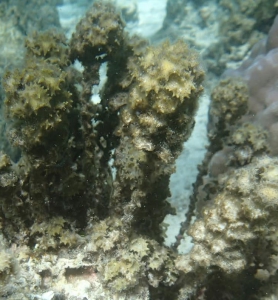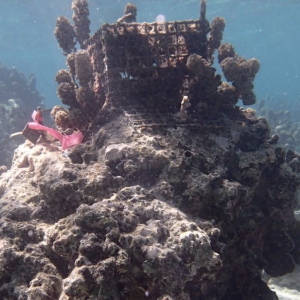Corals and Seaweed: The Fight for Dominance
By Konnor Payne, SRC Intern
Coral reefs exist because the environment around them gives them the means to survive. These conditions are also the perfect environment for seaweeds, which compete with the corals for space. Worldwide, there have been recorded occurrences of transitions from coral to seaweed dominance. Researchers at the University of California Santa Barbara theorized that this was due to the overfishing of herbivores that would otherwise keep the seaweeds at bay, or nutrient enrichment, leading to an explosion of seaweed. To test this hypothesis, they traveled to the barrier reef of Moorea, French Polynesia. This reef had experienced an outbreak of coral-eating sea stars in the past few decades that reduced the coral cover to less than 5%. For unknown reasons, the fore reef (outer slope) has recovered but not the corals in the lagoon (back reef), which have been taken over by a seaweed called Turbinaria ornata. Investigating the difference in the corals’ resilience along the fore reef and lagoon could give insight into herbivory tipping points to maintain a coral-dominant environment. There was also a chance of “hysteresis,” or the idea that a slight change in one parameter produces an environment that requires a more significant change in the same parameter to return the environment to its original state.

Figure 1. Adult Turbinaria ornata in Moorea, French Polynesia that compete with corals for space and resources (Schmitt, 2019).
The resilience test was conducted in the lagoon by mimicking storms’ varying intensities for 26 months on patch reefs and observing their recovery over 37 months. The researchers replicated a storm disturbance by removing all or parts of seaweed on the sample site. The researchers compared the abundance of coral at the beginning of the experiment to the end. The corals were highly resilient to a moderate disturbance, but not severe disturbance, from which they failed to recover and became dominated by turf algae. If the amount of herbivory is insufficient, the area will convert fully to seaweed dominance due to fishing pressure.

Figure 2. The exclusion cage is placed on a patch reef to limit herbivorous fish’s body size that graze on it (Schmitt, 2019).
To test for hysteresis, a series of cages with various-sized holes were placed across patch reefs to limit the herbivorous fish body size, limiting their feeding capacity (Fig. 2). The researchers left these sites for as long as needed until the system naturally reached a stable state. The researchers found hysteresis at both sites by comparing the stable states of coral versus seaweed across the fore reef and lagoon. However, the standard conditions on the fore reef had herbivory action high enough to prevent seaweed dominance. In contrast, the lagoon is on the tipping point. The lagoon is at risk for completely transitioning to a seaweed-dominant environment, whereas the fore reef will likely remain coral-dominated. The researchers concluded that reversing an undesired shift on coral reefs would be difficult due to the hysteresis effect. The results suggest that proactive management strategies to prevent shifts in the first place will be more effective than management strategies targeted at restoration.
Works Cited
Schmitt, R. J., Holbrook, S. J., Davis, S. L., Brooks, A. J., & Adam, T. C. (2019). Experimental support for alternative attractors on coral reefs. Proceedings of the National Academy of Sciences, 116(10), 4372-4381.
